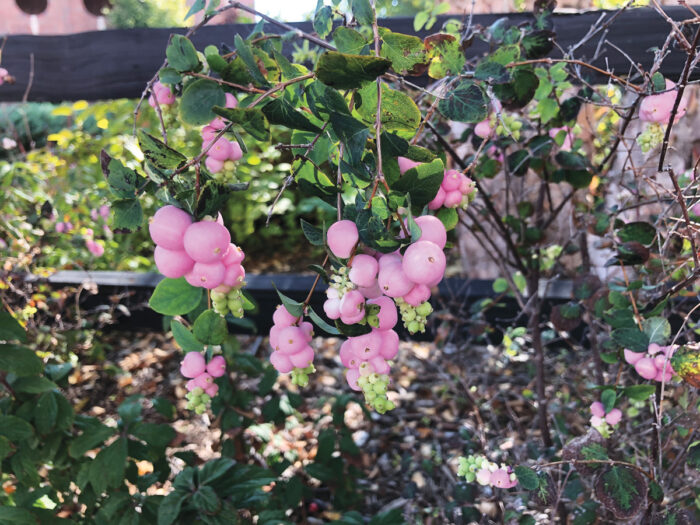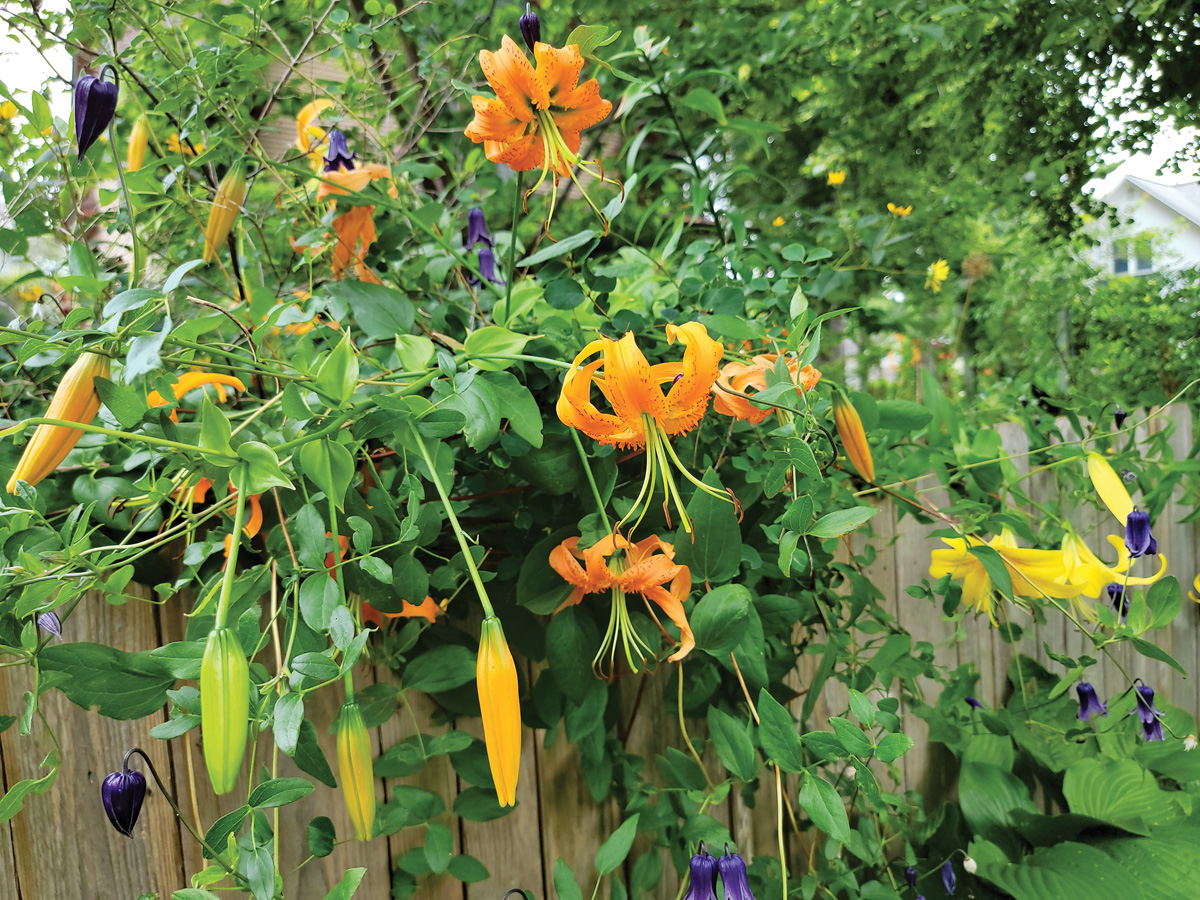
The following selections exhibit a remarkable ability to grow in a variety of lighting situations, including those outside of their preferred conditions.
Shrubs
The super-showy fruit of Proud Berry® coralberry grabs your attention wherever you plant it
Name: Symphoricarpos ‘Sofie’ (photo above)
Zones: 3–7
Size: 3 to 4 feet tall and wide
Conditions: Full sun to partial shade; moist to average, well-drained soil
Native range: Hybrid
Coralberries are underutilized shrubs. The cultivar Proud Berry® is the result of a complex hybridization that involves several native species, including common snowberry (S. albus, Zones 3–7). At 3 to 6 feet tall and wide, snowberry makes a great hedge or specimen plant. In comparison, Proud Berry® coralberry is more compact, and its pink fruit is much larger. These berries will increase in color intensity as temperatures cool. I am so enthralled with this impressive display late in the season when we need color the most that I have at least six of these shrubs in my own garden in areas from full sun to shade. When they are covered in fruit, passersby never fail to ask what they are.
Stunning variegation allows ‘Pearl Frost’ Japanese orixa to stand out anywhere
Name: Orixa japonica ‘Pearl Frost’
Zones: 5–8
Size: 6 to 8 feet tall and 4 feet wide
Conditions: Full sun to full shade; well-drained soil
Native range: Japan, South Korea
I’m sure that most gardeners have never heard of Japanese orixa, in part because it isn’t common in garden centers and may have to be obtained through mail order. That is a shame, because this plant is garden worthy for its shiny green foliage, not to mention its adaptability. Its glossy, smooth, thick leaves allow water to wick off quickly, preventing the development of most fungal foliar diseases. There are a few cultivars of this rare shrub; my favorite is ‘Pearl Frost’, whose foliage is edged in creamy white. You can never go wrong with variegation, especially in shade, and this one is a stunner all season. It is slower growing than the species, making it a better fit for small gardens.
Perennials
‘Shrimps on the Barbie’ lungwort isn’t just for low-light areas
Name: Pulmonaria ‘Shrimps on the Barbie’
Zones: 4–9
Size: 10 inches tall and 18 to 24 inches wide
Conditions: Full sun to full shade; moist, well-drained soil
Native range: Hybrid
Lungwort is one of those true “remembered from Grandma’s house” plants that are recognizable by most gardeners. This plant is ubiquitous for a reason, as it is durable and adaptable. Flowers emerge before trees bud out, and the foliage grows strongly in shade; however, this perennial can also thrive in full sun if the soil doesn’t dry out. Lungwort is grown for its beautiful early spring white, pink, blue, or purple flowers that recede to give way to bold-textured, elongated mounds of leaves with silver spots or streaks. The recent show-stopper introduction ‘Shrimps on the Barbie’ has entered the market with a truly unique look: bright, shrimp-pink, almost orange flowers. This look has delighted every gardener who has seen it and made something truly unique of a common plant. Its short, gracefully mounding habit makes this selection a great ground cover as well.
Bristle-leaf sedge is a versatile ground cover for any part of the yard
Name: Carex eburnea
Zones: 2–8
Size: 8 to 12 inches tall and wide
Conditions: Full sun to full shade; moist to dry, well-drained soil
Native range: Northern and eastern North America
Sedges have become very popular in recent years, especially as lawn alternatives, although they are also texturally useful in perennial beds with their graceful, flowing foliage. Some of the most popular and widely available sedges are shade denizens, such as Pennsylvania sedge (C. pensylvanica, Zones 3–8), and burn badly if planted in hot, full-sun and dry-soil conditions. It is worth tracking down the lesser-known bristle-leaf sedge for an option that can take either sun or shade. The increase in native plant nursery suppliers is making it more available, although be sure to order early because it usually sells out. At only around 8 inches tall and spreading via rhizomes, this sedge makes a superb deer-resistant lawn alternative or ground cover that holds up to sun and heat, although it should have some shade if the area is prone to drought.
Henry’s lily is a late-blooming wonder that will sparkle in the understory or in the border
Name: Lilium henryi
Zones: 5–8
Size: 4 to 8 feet tall and 2 to 3 feet wide
Conditions: Full sun to partial shade; average to moist, well-drained soil
Native range: South-central China
As a Lilium lover, I must include a species lily such as the lovely Henry’s lily in my list of adaptable plants. Many species lilies are tolerant of shade simply because they bloom earlier than the foliage of most deciduous trees fully emerges, creating more sunlight in a spring shade garden. Henry’s lily deviates from this trend; in fact, it’s the last lily to flower in my Midwest garden—in late July going into August. That extends the bloom beyond the time the more common Asiatic, oriental, trumpet, and orienpet species finish for the year. I love this late-flowering specimen plant so much that I have it in several areas, from full sun to shade. Typical of species lilies, the blossoms are smaller and more numerous than the more familiar forms listed above. These blooms have reflexed petals and are bright orange with maroon spots; they will give you a bright, showy, summer splash of color. You can plant Henry’s lily in the middle to rear of your perennial border; my plants can easily reach 8 feet tall.
| DID YOU KNOW? |
Pioneering trees show how adaptability works in the wild
Some of the most adaptable trees are those we call “pioneering” species. These are native trees such as aspens (Populus spp., Zones 2–9), eastern red cedar (Juniperus virginiana, Zones 2–10), and willows (Salix spp. Zones 4–9), and they are the first to repopulate a devastated ecosystem such as one destroyed by a fire or flood. They grow and spread quickly under adverse and changeable conditions at the edge of forests, advancing into open spaces. Since they are often on wooded edges, they must be able to tolerate sun and shade. Those that grow along marshes or water bodies must survive spring flooding in areas that turn hot and dry later in the season. Few plants will thrive under relentless variable conditions long-term, but those that adapted under changeable seasonal conditions will have a better chance.






















Comments
Log in or create an account to post a comment.
Sign up Log in